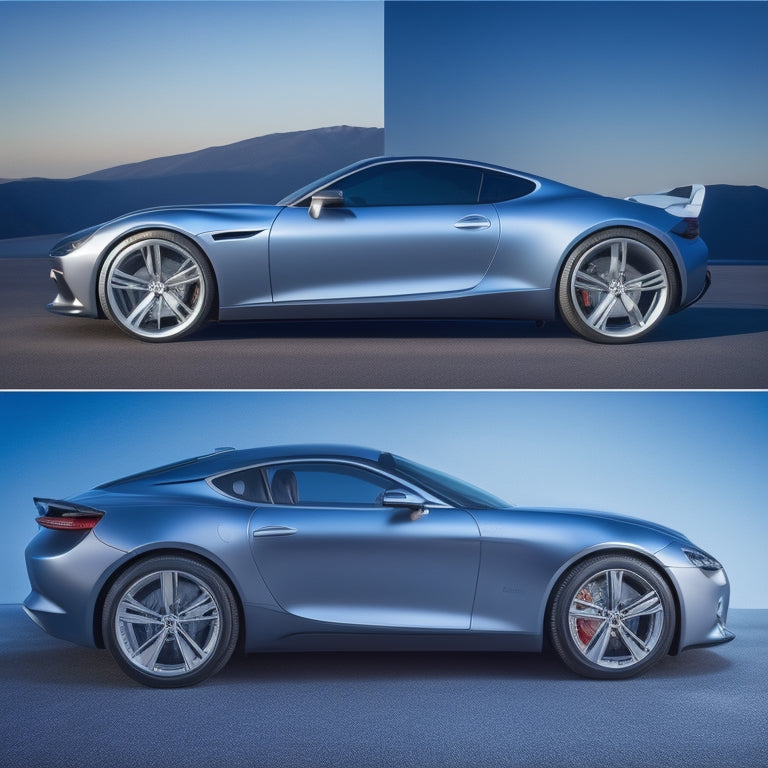
Optimize Your Ride: 5 Aerodynamics Design Tips
Share
You can optimize your motorcycle's aerodynamics by streamlining its body, reducing sharp edges and protrusions, and applying aerodynamic fairings. Upfront, focus on nose cones and front fairings to reduce wind resistance, and modify the windscreen angle for optimized airflow. Smooth out wheel wells and install aerodynamic hubs to reduce turbulence around wheels. At the rear, use a spoiler and tail fin to minimize turbulence. Finally, fine-tune your riding position by lowering handlebars, sliding the seat forward, and experimenting with different body positions. By applying these tips, you'll be on your way to a faster, more efficient ride - and there's even more to explore.
Key Takeaways
• Smooth the motorcycle's body to reduce air resistance by eliminating sharp edges, protrusions, and cavities.
• Focus on nose cones and front fairings to reduce wind resistance upfront, optimizing windscreen angle for improved airflow.
• Smooth out wheel wells and install aerodynamic hubs to reduce turbulence, using wheel spats or fairings to redirect airflow.
• Minimize turbulence at the rear by using a rear spoiler and tail fin, paying attention to angle and shape for optimal performance.
• Fine-tune the rider's position by lowering handlebars, sliding the seat forward, and experimenting with different body positions to reduce wind resistance.
Streamline the Motorcycle Body
To reduce air resistance, focus on smoothing the motorcycle's body by eliminating any sharp edges, protrusions, or cavities that can create turbulence. You want to create a seamless, aerodynamic shape that allows air to flow smoothly around the bike. This is where body sculpting comes into play.
By reshaping the motorcycle's body, you can reduce drag and improve overall performance. Aerodynamic fairings can be a great solution to achieve this. These custom-designed panels can be fitted to the motorcycle's body to streamline its shape, reducing air resistance and turbulence.
You can also consider applying a sleek, high-gloss finish to the body to further reduce drag. Remember, the goal is to create a smooth, continuous surface that allows air to flow effortlessly around the bike.
Reduce Wind Resistance Upfront
Frequently, the most crucial area for reducing wind resistance lies upfront, where the motorcycle's nose cone and windscreen can create significant drag if not designed with aerodynamics in mind. As you modify your ride, it is important to focus on this critical zone to minimize air resistance. A sleek, streamlined front fairing can make a substantial difference in reducing wind resistance.
| Design Element | Aerodynamic Impact |
|---|---|
| Nose Cones | Reduces wind resistance by up to 15% |
| Front Fairings | Enhances airflow, reducing turbulence by 20% |
| Windscreen Angle | Optimizes airflow, reducing drag by 10% |
Optimize Airflow Around Wheels
By focusing on the area around your wheels, you can further reduce air resistance, as rotating wheels can create turbulence that increases drag, especially at high speeds. This is particularly important, as wheels can account for up to 30% of a vehicle's total drag.
To optimize airflow around your wheels, consider the following:
-
Smooth out wheel wells: Make sure your wheel wells are smooth and free of any obstructions or rough edges that could disrupt airflow.
-
Install aerodynamic hubs: Aerodynamic hubs can help reduce turbulence around the wheel by smoothing out airflow around the hubcaps.
-
Use wheel spats or fairings: Adding wheel spats or fairings can help to redirect airflow around the wheels, reducing turbulence and drag.
Minimize Turbulence at the Rear
Minimizing turbulence at the rear of your vehicle is vital, as the airflow detachment point greatly impacts overall drag, and even slight enhancements can greatly improve aerodynamic performance. By reducing turbulence, you'll experience a significant decrease in drag, resulting in improved fuel efficiency, increased speed, and enhanced overall performance.
A well-designed rear spoiler plays an essential role in minimizing turbulence. This component helps to redirect airflow, creating a more streamlined flow that reduces the detachment point, thereby decreasing drag. Consider incorporating a tail fin, which can further enhance the spoiler's effectiveness by creating a more defined airflow separation point. This combination will help to create a smoother airflow, reducing turbulence and resulting drag.
When designing your rear spoiler and tail fin, pay close attention to the angle and shape. A more aggressive angle can increase downforce, but be cautious not to compromise airflow. A curved or tapered shape can help to reduce turbulence, while also improving overall aesthetics.
Fine-Tune the Rider's Position
As you've optimized your vehicle's rear spoiler and tail fin to reduce turbulence, it's now time to focus on fine-tuning the rider's position to further enhance aerodynamic performance.
You've made significant strides in minimizing turbulence at the rear, but now it's time to turn your attention to the most critical component: you, the rider.
To optimize your position, consider the following adjustments:
-
Handlebar Height: Lower your handlebars to reduce wind resistance and create a more aerodynamic profile. Experiment with different heights to find the sweet spot that balances comfort and performance.
-
Seat Adjustment: Slide your seat forward to reduce the distance between your body and the handlebars. This will help reduce air resistance and create a more streamlined shape.
-
Body Position: Experiment with different body positions to find the one that minimizes air resistance. Try leaning forward, tucking your elbows, and keeping your head down to reduce wind resistance.
Frequently Asked Questions
Can I Apply These Aerodynamics Design Tips to Bicycles as Well?
As you rev up your ride, wondering if aerodynamics magic can boost your cycling speed, you'll be thrilled to know that, yes, you can apply these design tips to bicycles, tweaking your bike frame for a sleeker, faster ride.
Do Aerodynamics Design Improvements Affect Motorcycle Engine Performance?
When you tweak aerodynamics, you'll notice torque gains, as improved airflow dynamics around the engine and exhaust system reduce air resistance, allowing your motorcycle's engine to breathe easier and produce more power.
How Do I Measure the Aerodynamic Improvements I've Made?
You'll want to quantify the fruits of your labor by delving into data analysis, leveraging tools like wind tunnel testing and flow visualization to measure drag reduction, ensuring your aerodynamic tweaks translate to tangible performance gains.
Are There Any Specific Materials That Aid in Aerodynamic Design?
When selecting materials for aerodynamic design, you'll find that carbon fibre and lightweight panels are ideal, as they reduce weight while maintaining structural integrity, allowing you to optimize airflow and minimize drag.
Can I Use Computer Simulations for Aerodynamics Design Testing?
"Think you're a master of air, don't you? Newsflash: you're not. But, yes, you can use computer simulations for aerodynamics design testing via CFD Analysis, creating a Virtual Wind tunnel to fine-tune your design before hitting the road."
Related Posts
-

Best Vehicle Chargers to Keep You Moving
You're looking for a reliable vehicle charger to keep your devices powered up and stay connected on the go. Solar cha...
-

Best Online Solar Panel Systems for Small Homes
When choosing the best online solar panel system for your small home, consider top-rated brands like SunPower, Panaso...
-

5 Best Online Stores for Green Vehicle Solutions
You're on the hunt for an eco-friendly ride, and online stores are a great place to start. You'll find top retailers ...


